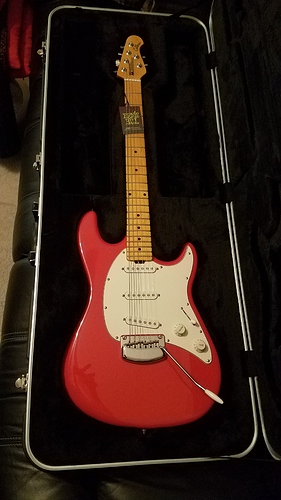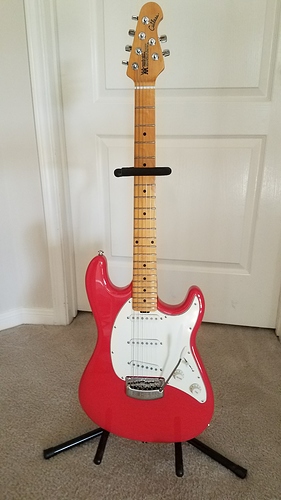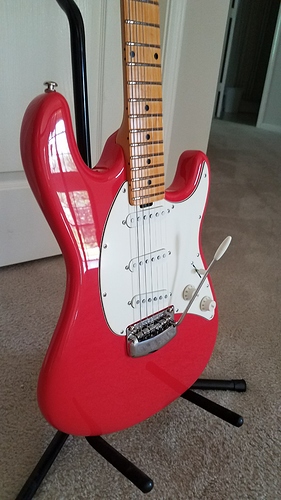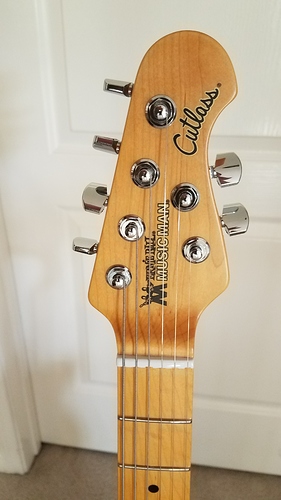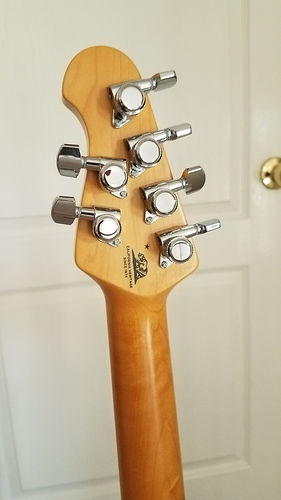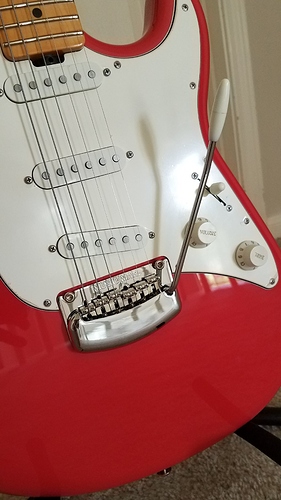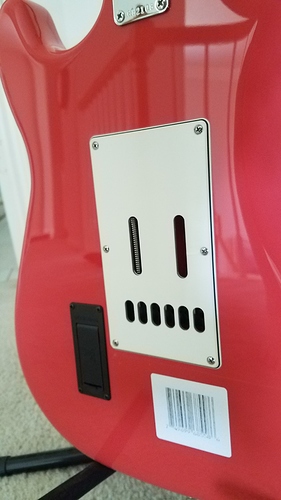Have you tried bringing some headphones with you? You could probably plug them into the amp to hear what’s going on.
Yeah, I’ve thought about it, but I’m not sure many amps have headphone-out jacks… but I honestly didn’t ask.
Once I concluded that the G&L they have isn’t the one for me (and my conclusion was based mostly on feel anyway), I left. If I’m going to end up just getting a regular Fender, I strongly prefer to buy from my FNGS rather than do business with the big corporation.
But now I’m pretty much back to square one… only a few Strats in my price range to choose from. I may need to take a road trip to LA or NYC or somewhere just to get a decent selection…!
Edit: a bit more on the “feel” thing… it’s about the neck thickness. Strats and G&L guitars have a 9.5" fretboard radius, and I found that to just be too chunky. Not sure why that one felt better than the others; all Strats apparently have that radius. My current electrics all have 12" radii, and that feels much more natural to me. So it’s kind of back to the drawing board… probably going to try out the Ernie Ball Music Man Cutlass I posted about earlier in this thread, which has a 10" radius and see how that feels. Definitely worth the restocking fee to me if I have to send it back…there simply isn’t one within several hours’ drive of me to try out in person.
No, you don’t need a Strat. You won’t die without one, you won’t starve. You won’t be homeless if you don’t get one.
Now I read clearly that you WANT one, but that’s not a NEED.
Are you referring to the depth of the neck in your hand? If it’s a 9.5 radius and it feels too big,a 10" radius will be a touch wider, but there may be less wood behind the fingerboard. The best feeling Strat neck I’ve played was the Eric Johnson model, which was deep but not wide, and fit down into my relatively small hand perfectly. (No Trump jokes, please). If you’ve played your acoustic a lot more than your electric, you may really like a flatter neck.
I think he was implying that a strat is necessary for certain elements of a musical production because they have a rather unique sound…
I don’t think he implied it was an essential human necessity such as food or shelter.
See… ‘will I suffocate or starve without a strat’ vs. ‘is a strat ‘needed’ on a particular track’
Thanks for the assist J! Clearly the hyperbole of my subject line was way over the top, and there was not nearly enough context from the previous 120+ posts. I should really be ashamed. 

Yep Bob, that’s it exactly. I have no issue with the width, but rather the depth or, to put it another way, girth. The ones I played were a US$600 Standard (doubtless MIM), a $900 Roadhouse (ditto, I expect), and a $1450 US made Professional. The latter was nicer for sure, but they all just felt “fat” in my neck hand with the exception of one of them (and that was one of the two less expensive models, but I don’t recall which). The used G&L was tagged at $899.
I have in fact played acoustics vastly more than electrics. Until about six years ago, I hadn’t owned one since not long after high school, when I played in a goofy garage band with some friends. Traded it in on a banjo in about '79, and played exclusively acoustic all those intervening years. (Traded the banjo in on a new-to-me but used 12-string in about '83 if memory serves.)
I didn’t set out to have higher-radius necks on the electrics, it just worked out that way. My first one after all that time was a Dean Soltero, which I kept for about a year and a half before trading it in on my Variax in Feb '12. After that I picked up the Heritage 535 from a friend out in California in March '14, and then added the Les Paul in April '16. They all happen to have 12" radii.
(post withdrawn by author, will be automatically deleted in 24 hours unless flagged)
Alright, that’s enough. If you don’t want to read about this, then get the fuck out of my thread. How I spend my hard-earned money is none of your damned business. I have greatly enjoyed talking about a new guitar purchase with my friends here, as friends are wont to do as they hang around shooting the breeze. I make no apology for having the means to afford nice instruments. It’s my sole indulgence, but I don’t have to justify that to you or anybody else. You have no right to judge me (or anyone) about what is or is not a luxury and what is or is not spending “too much”. So please kindly piss off and go read something else.
Okay, here are my last suggestions to add to the confusion:
-
One of the main differences in how I play a Strat is the use of my thumb to fret some of the chords that require a little more stretch. Next time you play one that feels a little chunky, work your thumb a little more, it may feel more comfortable while you’re getting used to it.
-
Do some research into the type of neck that feels best to you on both Fender’s site, and on replacement neck websites. For instance, Fender offers necks that they call Soft-V with a radius of 7.5" that are easy to bolt on to most Strat bodies. This would allow you to check out a bunch of MIMs with the idea that if the neck wasn’t perfect for you, a perfect replacement can be had to be popped in for about $200 to help you build a tailor made Strat reasonably. The trick is to be familiar with what the different necks feel like and equate that to their measurements. You’ll also find lots of necks available online from other swappers that are in very good condition inexpensively. Many guitar techs remove the neck from the body for fretwork, so don’t worry too much about the process. At the very worst, necks that do not fit perfectly generally only need a very small shim placed in the pocket to get it perfect and stable.
IMHO, Strats were originally designed as the perfect box of parts thrown together to make a great, affordable guitar that you can customize to make it your own. Since you mentioned you would keep it, you don’t have to worry about resale, and you could build a beautiful instrument however you wanted it for the cost of an American Strat.
Bob, I totally get what you mean here. However, I just never bring my thumb over the top. When I first learned, it was all classical for many years, and it is just drummed into you that the thumb never ever gets much above the midpoint of the back of the neck. I just can’t do it, it’s way too ingrained in my muscle memory. I am fully aware that many, many great rock guitarists use the thumb over the top, but it would require a wholesale revision in how I play, and that ain’t happening. I do get it above that midline a lot when I’m playing electric, particularly when doing bends and so on, but I’m really not much of a lead player so those occasions are comparatively rare.
Re: a 7.5" radius neck, that would be even worse, no? The girth increases as fretboard radius decreases. So a 7.5" neck would feel even fatter to my hand than a 9.5". Granted, a 10" is not that big a change, but just about every review of the EBMM Cutlass I’ve seen makes a point of how nicely thin the neck feels in the hand at its 10" radius.
I have in fact gone ahead and ordered a Cutlass from Sam Ash and will take my time during their no-questions-asked, 45-day return period to thoroughly check it out. If I end up having to send it back, so be it… the restocking fee will be a lot less than the gas I would have to buy to travel halfway across Texas to play one!
Yes Jonathan, and on that note…
Something happened last night that I never imagined would happen…
During my last session with The Detective I decided to show him my old Mudslinger tune… loaded the project and it now went into Cubase 8, of course… “such a long time ago”…
It totally sounded like crap and I certainly hope it was something in the conversion process that did it…
(Images of my forum friends nodding and saying 'it sounded like crap, that is right.)
Anyway - I decided to redo the tune, but I had a hard time playing it on the LP and in the end I gave up and took out the old Ibanez Gio. On which I suddenly could play it. It is hotter than the Gibson and has really thin strings.
So hence, I found I needed the Ibanez. No ifs and buts about it…
S
As to the radius, sort of yes and no, as the radius of a 7.5" circle is smaller to start with, and the soft vee shaping fits down into the hand deeper, not wider. The point is you can find a shape you like, and have it shaved to fit your hand. Music Man makes great guitars, and players remark about the feel of the neck, so you may be on to something there too.
Right-- deeper, not wider. It’s the depth that is the issue, so I’m definitely not inclined to get an axe that has an even deeper feel than the ones I already don’t care for and then try to mod it into submission… would much rather find something that I like without having to do that. I’m in no hurry-- if I have to mail-order several guitars before I find the one that fits, that’s cool by me! 
OK-- I took delivery early this afternoon on an Ernie Ball Music Man Cutlass. Played it for about five hours, and the first impression is stellar.
I was sort of expecting that my initial reaction to the neck would be similar to how I felt about the G&L that I played recently, which has a 9.5" radius fretboard. The Cutlass has 10". But it feels so nice and natural in my hand, I was instantly at home with it, to my surprise. Very much in line with all of the reviews I’ve read and watched. It also comes with stainless steel frets, which should pretty much never wear out. They feel super smooth, almost a mirror finish on them. Bends are a breeze.
Playability is fantastic. Smooth, fast action, perfectly set up right out of the box. Fit and finish are superb. Not a single blemish or rough spot, neck perfectly seated and aligned. And Bob @StylesBitchley, this neck allows my thumb to get right up to the top edge without making my muscle-memory rebel against it, so that I can fret in a way that’s conducive to playing rock and blues stuff. No fight in there at all thus far. Still am not going to fret the E string with my thumb, that’s a bridge I’m sure I’ll never cross. But I can get my hand into the right posture for sure.
It is equipped with Schaller locking tuners, and the 4/2 configuration of the headstock machines means that every string is a straight pull, no angles and without that little clippy thing that Strats have. Ostensibly this should promote the guitar staying in tune.
Here are some photos, and then a handful of short clips I dashed off with a variety of amp sim and pickup selection settings. I’m going to play the crap out of this guitar all week before I make up my mind for sure, but there will need to be some egregious shortcomings to overcome the great first impression. Two things I will be paying close attention to are how well it stays in tune in general, and how well it stays in tune after using the tremolo arm. I have zero experience with a whammy so I will need to push and prod at that at some length.
So without further ado!
Now for some sounds. A major feature of this guitar for me is the “active circuit” that eliminates the hum of typical single-coils. Purists will insist that there’s no way to get the “real” tone with such a configuration; all I know is it sounds absolutely like the real deal to me. (The little black panel on the back is where the 9V battery goes to drive the active circuit. Battery life is about 500 hours of continuous playing.)
First some clean sounds. Here’s the middle pickup using the Scuffham “Fenderlicious” preset.
Here are the in-between positions (with signature Strat “quack”) using the GTR “Edgy clean” preset. First half is the position between neck and middle p/u, second half between middle and bridge.
Here’s some effects-y sounds. This is on the neck pickup with the CLA guitar sim using the “Late Night” preset.
Here’s a bit of grit using the Scuffham Steely Ray Blues preset. First the mid pickup, then bridge, then neck.
Here’s something crunchier, using the Scuffham Duke’s Blues preset and the bridge pickup. (bonus dive bomb at the end!)
Finally, here’s a highly f/x’d sound using the middle pickup and Scuffham’s House Burning preset.
I will report back again later in the week after giving it the full workout. I have 45 days to return it… 
Wooh Dave… sounding very cool!!! And so glad you included pics, that’s a sexy wee beast and loverly tones coming through. Looking forward to hearing more!
:beerbang:
Nice! Now that you have some tones kickin, don’t forget to play try throwing that Voxengo at the end of your chain! Also, an LA-3A -> LA-2A, or an 1176->LA2A can sound really cool on the stuff you just played 
When you said you have the CLA guitars, are you talking about this?
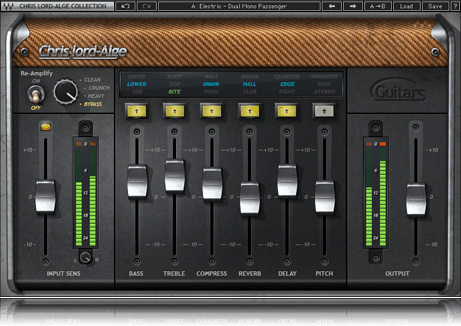
This plugin is the most not intuitive plugin ever created. lol.
If this is what you have, there’s a few tricks with this you may want to keep in mind. First of all, if you have the Scuffham set, always leave the re-amp knob off. This thing offers you nothing that Scuffham doesn’t do better.
Next, some people don’t know this, but in order to completely deactivate a fader (say delay, or pitch), you have to turn the light off AND move the slider to zero. These aren’t faders, where bottom is 0 db, and top is +12 or something. Here’s how this works. Say Treble is set on ‘bite’. The slider when set at zero (in the middle) is adding bite. That is the ‘default’ eq curve that Chris Lord Alge chose. Now normally you’d drag it down to lessen the amount of ‘bite’, but you’re not lowering it, you’re just chaining the EQ curve. I hope that makes some sense.
This plugin is meant to be used on GROUP BUSSES. So to get a CLA sound, run it after your scuffham rig. Then…
-If you have multiple tracks a Scuffham clean tracks, group your clean guitars into a CLA bus, and set the CLA on that bus to ‘clean’.
-If you have multiple crunch tracks, group them together and dump CLA on that bus.
-Then do the same thing with your leads
Etc…
Also remember, that CLA built this plugin for HIMSELF. So if you’re not familiar with his mixing techniques, this plugin might not make a lot of sense without it.
I’m gonna post a link to the vocal version, which operates the same way. Might help you out if you get a sec.
Ok…here’s a demo I did with the vocal version. But the guitar plugin operates the same way.
For maximum CLA effect, LEAVE ALL FADERS AT ZERO. Then make all your moves with input and output sliders.
@Emma: Thanks! Glad you like the looks and sounds… I sure do too.
@Jonathan: Yep, that’s the plug I have, and MANY thanks for the description of how it operates. That was all news to me. I will experiment with the type of use you outlined, that’s very helpful. And when you say “throwing that Voxengo at the end of your chain”, which Voxengo do you mean? I have a bunch of their plugs…
I have a DAW project file called “electric practice” where I have a bunch of tracks set up with the various amp sims I own, which makes it really easy to switch back and forth when I’m just nooding around like I was here. So I didn’t take more than about five seconds on any one tone, I just wanted to get a few samples for posting.
Wow that sounds real nice and it’s good looking too. My first guitar purchase was a Fender MIJ Strat (around 1986?) and I love it. I’m probably just overly influenced by the fact that the bulk of my guitar heroes were big Strat guys (Blackmore, Vaughan, Moore, Malmsteen, Johnson, Murray & Smith, etc…) but I also love the Stratocaster look. To me it’s what a guitar should look like. 
Possibly BOOGEX? @O
